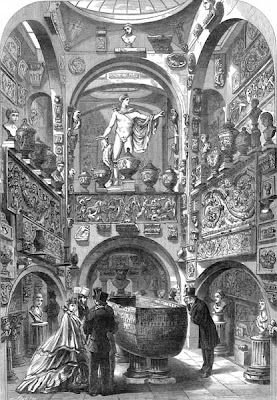

As the above paintings by Johann Zoffany (1733 –1810) demonstrate, the first of Charles Townley in his library, surrounded by his collection of classical artifacts, and the second, a detail from The Tribunal of the Ufizzi (full painting and legend below), the Georgians could be obsessive collectors. Part of a young gentleman's education was 'The Grand Tour', which involved an 'OE' through Europe, visiting places of archaeological, historical and artistic interest. Along the way, One collected as many petit meuble as One could carry. These were displayed once home in order to demonstrate One's wealth and education. One of the exemplars of this life was Sir John Soane, an accomplished architect and an avid curator of architectural object d'arts.

Sir John Soane (above) was born at Whitchurch in Oxfordshire in 1753. He was the son of a mason. His real name was Swan, which he changed, first to Soan, and later to Soane. After attending school in Reading, he was employed as an errand boy by the architect George Dance the Younger. He trained as an architect after Dance noted his talent as an artist, first under Dance, and then Henry Holland.
In 1772, Soane gained the Royal Academy silver medal with a drawing of the elevation of the Banqueting House at Whitehall and, in 1776, the gold medal with a design for a triumphal arch, along with a travelling studentship. He went to Italy, where he spent three years, mainly in Rome, studying the classical ruins and buildings and making his own designs for public buildings.
Soane returned to England in 1780 and built many country houses, the designs for which he published in a volume in 1788. In the same year he was appointed architect to the Bank of England, which proved something of a launching pad for his career.
He had to rebuild the entire structure of the bank, a task which involved many difficulties due to the form and character of the site. The Roman/Corinthian architectural style which he employed was a great innovation. All his other important buildings in London have since been altered or removed.
Soon after his appointment as professor of architecture at the academy, Soane began to form, for the benefit of his pupils and other students, collections of antiquities, books and works of art; and, upon these, towards the end of his life, he expended large sums of money. In 1824, he purchased the celebrated alabaster sarcophagus brought from Egypt by Belzoni (below):
This, together with many casts and models of the remains of antiquity, gems, rare books and illuminated manuscripts, and the whole of his own architectural designs, he arranged in his house in Lincoln's Inn Fields, which he transformed into a museum, still present today:
He died at his house in Lincoln's Inn Fields on 20th January 1837, leaving the bulk of his property to the children of his eldest son, and was buried in the mausoleum which he had erected for his wife in old St. Pancras’ churchyard.

Above: The tomb of Sir John Soane, the masonry baldachino of which is said to have inspired the classic British telephone box:


Intaglio (from the Italian intalgiare, meaning to engrave) were one of the more transportable and eminently fashionable souvenirs of the day. They ranged in size from 1/2" to 1/2'. They were collected and then framed, as below:

;_Zoffany,_Johann.jpg)









How appropriate that you should discuss Zoffany, as I have been researching him recently, having bought a picture that may be by or attributed to him. (I am still awaiting information from Sotheby's, but I suspect it is not Zoffany; the style is more Pompeo Batoni, which wouldn't be too shabby either.)
ReplyDeleteThoroughly enjoyed this post so thank you for including the link in your comment on my post.
ReplyDeleteI had no idea Soane's name was originally Swan, nor that the iconic telephone box was inspired by his tomb.
I too collect intaglios and enjoyed viewing part of your collection. I was eagerly watching the lot that just sold this week at Sotheby's in London; quite a saucy subject matter with excellent provenance. It fetched a whopping 13,750 pounds. Take a look and see what I mean:
http://www.sothebys.com/en/auctions/ecatalogue/2016/pelham-public-private-l16322/lot.175.html